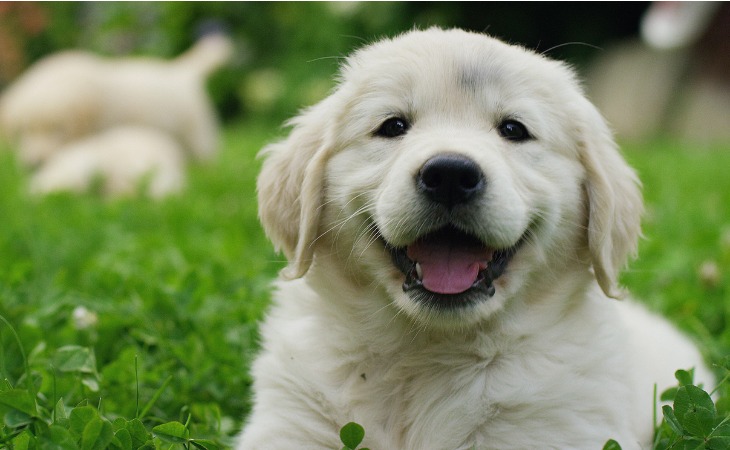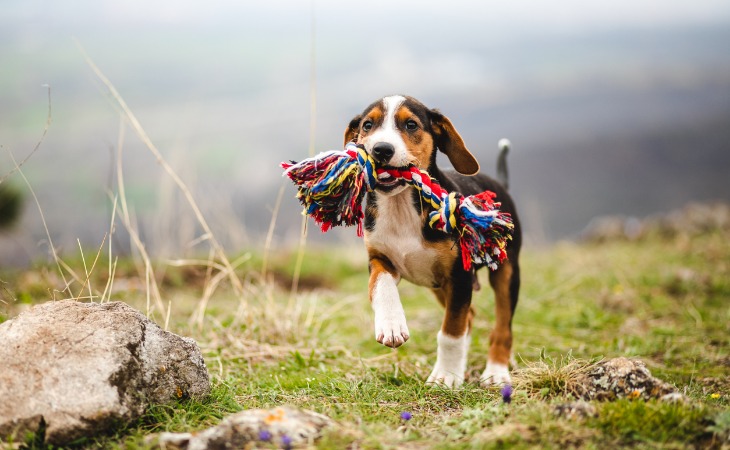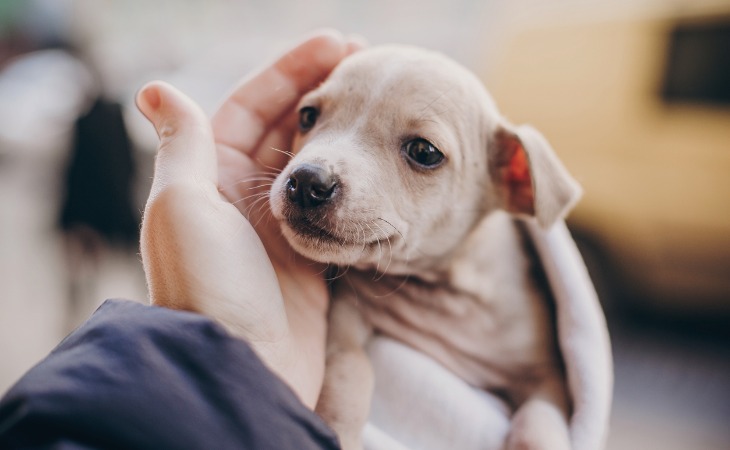Welcoming a new puppy to your home is an extraordinary adventure. Not only is it the beginning of a unique friendship and bond, but it’s also a huge responsability that should be taken seriously. When you adopt a puppy, you are commiting years of your life to their happiness and well-being. Thus, it is very important to be well-prepared. We’ll show you how to welcome your little ball of fur and give him the best life that you can give.
The first things you should do before adopting a puppy
To begin with, adopting a dog is not like buying a cute stuffed animal to hang out with! Your puppy depends on you. You will have to walk him and keep him active, even when it’s raining or cold outside. On top of that, you will have to feed him, cuddle with him, cheer him up when he needs it—just be there for you puppy. A dog is a living being. That means that you will have to take care of him 24/7.
If you are conviced that you are ready to take care of a puppy, that’s great! We are happy to share some advice with you!
Preparing for your puppy’s arrival
One of the first things that you should do before adopting your puppy is check the location of your nearest veterinarian. It’s important to visit the vet as soon as possible when you adopt a new puppy to get their vaccinations up to date. Your puppy is supposed to have received their first vaccinations at the shelter or breeder around two months of age. They should receive more vaccinations around three months of age, so it’s your job to keep this in mind. Dogs usually receive vaccinations every one to three years after that. You can always ask your vet when your puppy’s next vaccinations should be done.
When your puppy arrives, he will most likely be hungry. To ensure that your pup feels safe and has a place to eat, prepare a little eating area for him. Choose a place that’s easy for a small dog to reach and easy-to-clean. Ideally, a room with tile, such as the kitchen. That way, if your little one makes a mess with his water bowl or food, it’s not too much of a problem to clean.
A few things that your puppy might need
When your new puppy arrives at your home, he will start to discover a whole new area. Imagine being transported somewhere else without really knowing why you are being asked to leave your home. This is what your little one will feel when he is brought to your house.
For your dog’s well-being, it’s important to prepare a little corner where he can feel safe. You can choose a cozy mat or a basket, for example.
You can also buy dog toys for him to play with. Not only does this help to de-stress your puppy, but it’s also great for teething. You do not need to buy very many. It’s best to wait until you get to know your dog to see which types of toys he prefers.
To be ready for your dog’s first walk, try to find a collar (or a harness) and a leash.
Learning more about your new puppy
As you will be sharing your life with them, before you adopt a new pet, it is important to find out more about them. To do this, research about the breed that you are welcoming into your home. For instance, you can learn about the personality traits of a particular breed by visiting specialized dog websites on the Internet. This is a good option to get a general idea of the behavior your dog may have. This is important because some breeds are known for being rather shy, while others are playful and friendly. Some breeds are even a bit stubborn. Take the Shiba Inu, for example, which is a particulary independent dog breed.
Do not be afraid to ask the shelter or dog breeder for information. They have shared moments with your new puppy and should know quite a lot about him. Moreover, they have experience with pets and should be able to tell you whether your puppy is shy, naughty, or playful.
If your puppy is nervous or fearful, it is important to speak to him gently and not startle him. When you adopt your puppy, use positive education techniques to establish a harmonious relationship. If you feel lost, don’t hesitate to ask for help from someone specialized in canine behavior.
If your shelter or dog breeder tells you that your dog is curious or adventurous, do your best to make your living space safe. For instance, you should remove everything that could be dangerous for him, such as electric wires or toxic plants.
In addition, ask your breeder what type of food your dog is used to eating and the number of meals that he usuallys eat per day. This is to make sure that you do not suddenly change his eating habits.

After your puppy has arrived
It’s time! Your puppy has arrived! You can now start to get to know your puppy. Don’t forget that when your new puppy arrives, he is in completely unknown territory. He is probably wondering why he is in your care. He might even be confused and overwhelmed. Everything that he is used to is different now.
A new peace haven
To begin with, you should try to show him his new living space. Let him know which rooms he can access. It’s important to speak to him gently and let him build trust in you. At this time, you can try to introduce him to his eating and resting area. These zones should be quiet and peaceful.
The first few days after your puppy moves in with you, it’s best not to let too many people see him. Allow him the time to get used to his new family before you invite your friends over. In order to feel at home, your dog needs the time to find his place.
Be patient with your puppy
If your puppy does something that you do not like, such as pee on your floor, do not yell. Like babies, puppies do not know that it’s not good to do. Similar to babies, they will learn in time. In order to teach your pet to pee in the right area, set aside a small zone for your dog to pee at. When you see that he wants to relieve themself, carry him to that spot. If you show your puppy that you are happy when he does this well, he will learn faster. You can also reward your puppy to try to teach him. When your dog makes an effort, give him a small reward.
In addition to avoiding yelling at your puppy as much as possible, you should also avoid violence. Otherwise, you could make your puppy fear you.
Discovering the world with you
If your puppy comes from a shelter or a pet store, he has probably grown up quite lonely. On the other hand, if your dog comes from a litter raised in a private home, he probably already has a good notion of family life.
In any case, going out, will most likely be a new activity for him. When you first start walking your dog, it is necessary to put on a collar or a harness. Even if he finds it uncomfortable and strange, he will have to get used to this accessory. To get your dog used to it, put on the collar or harness at times that are pleasant for him, such as during his meal time or during a play session. This will help him associate the collar and leash with good memories. Start with short sessions and increase the duration as you go along.
Going for walks with you
Your dog will also have to learn to walk on a leash. This will probably be difficult for him as he is used to doing what he wants. Once your puppy gets used to wearing his collar, you can start to introduce him to the outdoors.
Once outside, your puppy will discover a new and incredible world full of new odors. He will act a bit like a child at Disneyland! He will want to jump around everywhere and will not yet know that he should stay close to you. Calmly try to make your puppy understand that you are the boss and that he needs to obey. For some, this will be easy. For others, it won’t. If you are having difficulties, you can plan a few hours of training at a specialized center.
Surprisingly, some puppies do not like to go on walks. You’ll have to make your dog see that it’s an enjoyable moment. To keep the outings interesting, bring along a toy that he can chase after. While playing, your dog will discover an amazing world of smells and noises that were previously unknown!

Everyone’s role in the family
To feel at home with his new family, your puppy needs to know who to turn to. For example, who in the house will be in charge of feeding your dog or other key moments of their day?
When your puppy wants something, he may try to persuade you to do things for him with his cute puppy eyes at times. There’s absolutely nothing wrong with that. However, it’s important that you set boundaries and stand your ground.
For a healthy relationship, it is best to use positive training. Train your dog with treats as rewards. If you do this, your dog will associate what he does well with rewards. If your dog is not a big fan of treats, you can also praise him or pet him.
Getting your puppy used to hanging around other people and pets
Once your pet starts to feel well integrated in your family, you can start to socialize him with other dogs. It’s important to do this from a very young age. During walks, do not hesitate to introduce your puppy to other dogs. Just make sure to ask the other owner about the sex of the dog and to know if the dog is more submissive or dominant. If the owner agrees, you can try to let them interact with each other.
Your pet should also learn to be around people other than his family.
Something that dog owners encounter too often is that a puppy attracts a lot of attention and people often try to pet them. Unfortunately, this can be a scary moment for a young dog. It’s important to reassure your dog and let him know that humans are not mean. Teach your dog to walk among people and accept getting pet by people he knows. It’s also important to be firm with strangers. They should not touch your dog without your permission. This is for your puppy’s well-being, as an animal that feels aggressed by unwanted contact may bite or become aggressive.
Setting up routines
As the owner, you will be part of your companion’s daily life and he will constantly refer to you. Especially at walking or playing time! The best thing to do is to establish a fixed routine from which you will not deviate to reassure your dog. For instance, you can go for a short walk at 7 in the morning and a long walk around 6 in the evening when you get home from work. Do your best to feed your dog at the same time each day.
Cuddle time allows you to create a strong bond with your puppy. It’s important to spend this time together. However, do not force him to cuddle with you if he does not want to.
You should not leave your puppy alone the first few days after his arrival. This is because he will still feel lost. However, after these first few days, it’s important that your puppy gets used to being alone. Let him adjust a little at a time. For example, you can start by leaving the house for a few minutes (to take out the garbage), then a bit longer (to buy groceries) and finally for a few hours (for work).
Your absence should not be a big deal. It’s better not to give your dog big hugs before going out. If your dog tends to get bored, you can give him toys to play with while you’re not there.

